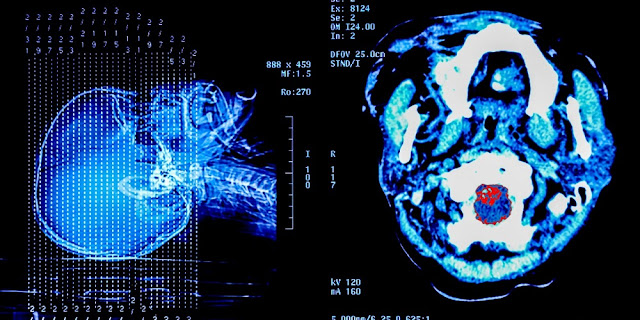University of Queensland highlights potential of ultrasound to delay the onset of Alzheimer’s disease
The University of Queensland is modeling possible treatments for some of the most debilitating illnesses such as Alzheimer’s disease. The Queensland Brain Institute, the University’s neuroscience research institute, is using its high performance computing system to model the behavior of ultrasound using an analysis technique called Finite Element Method (FEM).
The modeling calculates what happens to each element of the brain when an ultrasound is passed through the skull. It is hoped that ultrasound can be used to temporarily allow direct delivery of therapeutic drugs to the brain, something not currently possible due to the presence of a blood-brain barrier. The team also hopes to activate cells that can digest the plaques that are a hallmark of Alzheimer’s disease. The promising results will now be confirmed in a sheep study, an animal with similar skull properties as humans, and may be instrumental in developing treatments that stop or reserve degeneration, rather than just relieving symptoms.
I am inspired! And it’s Dell Technologies customers like the University of Queensland who give me hope for our future.
The University of Queensland (UQ) is consistently rated as one of Australia’s premier research-intensive universities by independent third parties. For example, UQ was awarded five out of five stars for research grants and research intensity by the Good Universities Guide. And the influential Academic Ranking of World Universities places UQ at 55th globally. To maintain these world-class rankings, UQ strives to empower its faculty with leading-edge high performance computing (HPC) systems. The latest example is the Wiener system, an HPC cluster designed in cooperation with Dell EMC to accelerate discovery and innovation.
Niche supercomputing for cutting-edge microscopy
The university’s Research Computing Centre (RCC) is tasked with managing HPC resources. The RCC has developed a strategy for broadening the HPC infrastructure base, built on the theory that it’s more cost-effective to serve different application types with different machines.
Launched in 2018, Wiener is the first ever dedicated GPU-accelerated supercomputer in an Australian university. It was designed specifically for imaging-intensive workloads generated by the University’s microscopy facilities and its world-class Lattice Light Sheet Microscope based at the University’s Institute of Molecular Bioscience. Wiener was developed and paid for with strategic funding from UQ and a consortium of the University’s various cutting-edge microscopy facilities.
The RCC worked in close partnership with Dell Technologies to develop the system’s capabilities. This groundbreaking project was completed in two phases. The first used Dell EMC PowerEdge R740 Servers as building blocks for processing data sets across 15 compute and analysis nodes, along with two additional nodes for visualization. The visualization nodes were included to provide processing power for a fully interactive experience to researchers viewing 4D data sets in real time at the edge of the scientific instruments throughout the university campus.
The second incorporated 15 Dell EMC PowerEdge C4140 Servers, each with two Intel® Xeon® Gold 6132 Scalable processors with 28 cores per node, 384GB of DDR4 RAM, four NVIDIA SXM2 Tesla 32GB V100 GPUs, 1.6TB of Dell EMC NVMe flash storage, and 100-Gbps Mellanox® EDR InfiniBand® networking.
The complete system includes 32 Dell EMC PowerEdge servers and 527,360 NVIDIA® Tesla® GPU cores distributed across the compute and analysis nodes. UQ wanted a system with multiple GPUs for parallel processing massive amounts of computational tasks such as those involved in data visualization and machine learning.
The supercomputer also leverages an open‑source, parallel‑cluster file system, designed specifically to manage I/O‑intensive workloads in performance‑critical environments. Both phases of the system are backed by Dell EMC ProSupport Plus for 24×7 technical support and assistance.
Half a million GPU cores in action
The Wiener supercomputer has a total performance of 11.3 petaFLOPS. Because the system has more than a half-million CUDA cores along with the parallel file system, it can easily handle multiple workloads, some of which generate 70–80 TBs of data per day. Researchers can process a single file at 105Gb/s, with up to 15 million IOPS.
“For the scale of machine learning to take place with the CPUs we previously had on campus, in some cases what we have now is 100 times faster,” says Jake Carroll, chief technology officer at UQ. “It’s literally untenable to run on CPUs [alone].” He continues, “The machine has become a plethora of massive machine learning and deep learning capabilities in the organization. It’s the focal point of AI computing at the University of Queensland.”
The cutting edge of accelerated technology
With the accelerated computing power of the Wiener supercomputer, UQ researchers can solve pressing global challenges while helping maintain the school’s status as a top research university.
“Given demand for the system is still going up, it is our intention to work with Dell Technologies to stay on the cutting edge of accelerated technology,” Carroll says, “and we would like to be the first in the Asia Pacific to deploy whatever technological leap in this area comes next.”





0 comments:
Post a Comment